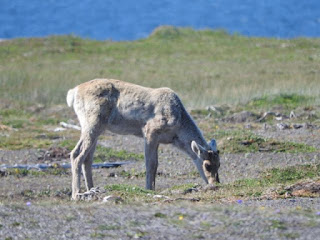Friday, August 5, 2016
We are camped at Gros Morne National Park, near Norris
Point, Newfoundland, Canada. We caught
the ferry from Labrador yesterday and are officially on our way home.
Newfoundland is a large island and Labrador is the most
easterly part of mainland Canada. They
are both rather sparsely populated and in order to be a Canadian province they
had to join forces. So, together, they
are Newfoundland and Labrador and most signs (and internet searches) refer to
them that way.
Last week we visited Port au Choix National Historic
Park, which is on Newfoundland’s western coast.
Our campsite was basic: water and electric at the site, no trees, but
this was our view:
At least, that was the view when the fog didn’t roll in.
Port au Choix seems barren and desolate. The landscape is classified as a limestone
barren.
But this area has been occupied for 5000 years. The sea, of course, provides fish, whales and
seals. The land provides berries and
meat, caribou in particular. And beside
the limestone in the area, other stone including soapstone, was available in
the region. Different types of stone
were used for different tools and soapstone was even carved into cooking pots.
The landscape seems barren, but we took a short walk
along one of the trails and I think I counted at least 6 different kinds
of berries. The limestone creates a
unique soil and there are plants here that grow nowhere else on earth.
There are two different kinds of berries in this picture.
This one is out of focus and I don’t know if it’s two
different berries or just a ripe and an unripe.
And then there was this one, which is on a stem like a
strawberry, but looks like a raspberry.
I apparently didn’t manage to take any pictures of the
strawberries. They were tiny, as were
most of the berries. But they still
apparently provided a nice meal for the local caribou, who showed no interest
at all in the humans around them.
Although one momma kept her eye on me as we approached.
The park used a few sculptures to tell the story of some
of the peoples who lived here. Like most
natives, they made good use of what they had.
This picture is a sculpture to give you an idea of their homes.
The base would be a circular stone wall with a mostly flat
top. These would be used for sitting and
sleeping. Whalebones would be use to
build the structure and give it shape.
And animal skins would be stretched between the whalebones to create the
walls and roof.
This sculpture depicts the processing of the seal skins.
The national park is next to the village of Port au
Choix, larger than some of the fishing villages. It has a fish processing plant and school and
profits from the tourists the park brings in.
It also has a Trip Advisor top rated restaurant. It’s not a fancy place, but the food is good
and most of it is local. I had cod for
dinner and Steve had a moose burger.
Both were delicious. We went back
the next day for lunch!
I’ll close for now.
It took me 2 hours last night to get to photos loaded to the web and I
have more in this post. I do miss our
high speed connection, but am lucky to have any connection at all.
Take care,
Deb











No comments:
Post a Comment